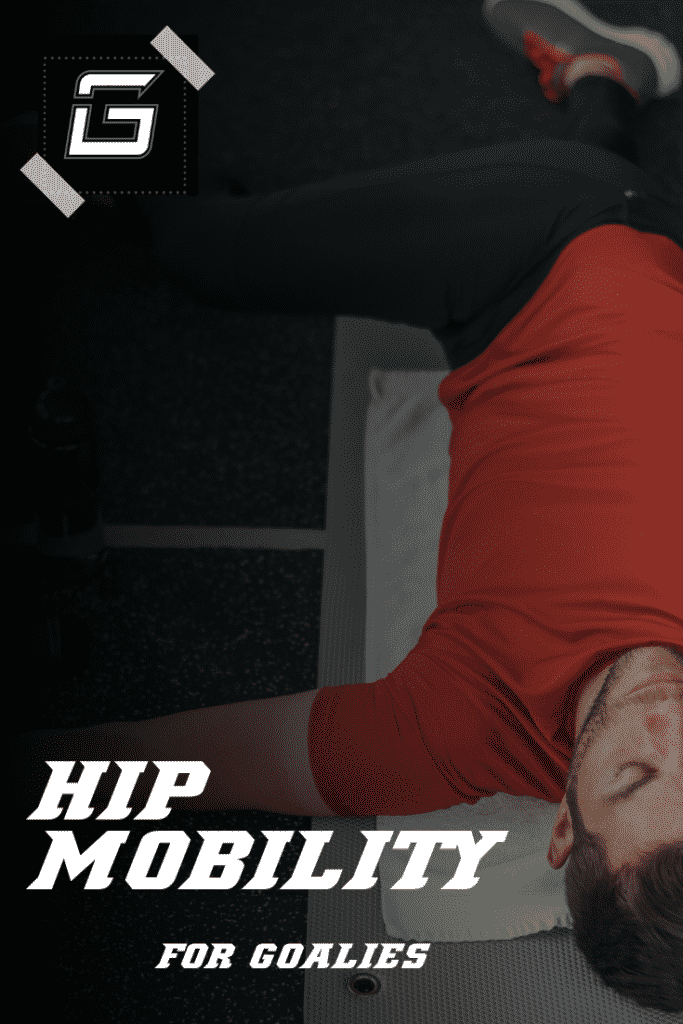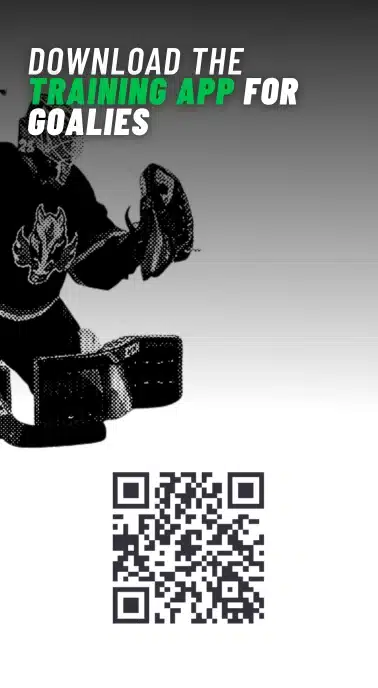The importance of hip mobility for goalies cannot be overstated. If you’re a goalie, you should be taking your hip health seriously. Take a look at Robin Lehner, goalie for the Vegas Golden Knights. It was announced that he would be out the entirety of the 2022-2023 NHL season because of a hip injury.
One of the top ways to prevent injury and increase longevity for goalies is by focusing on hip mobility through dedicated hip stretching routines. In this guide, we’ll provide a list of hip stretches that we use to create mobility routines for our goalies, as well as hip stretching ideas that will prolong your career in the net.
One of the easiest way to improve your hip mobility is by hip stretching. Your hips are critical to every day life, whether you’re a goalie, an adult, or a senior. At every stage of our lives, we need our hips to perform. The importance of hip mobility for goalies and a focus on improving it cannot be overstated.
The Complete Guide To Hockey Goalie Hip Mobility
Improving your overall hip mobility is critical to long term success as a goalie. Not only will focusing on improved hip mobility and stretching reduce your overall chance of injury, it will improve your ability to user certain techniques, such as the RVH (Reverse Vertical Horizontal).
Hip mobility is a crucial component of not only the well being of a goalie, but athletes in general. While athletes in every sport use their legs and therefor, their hips, to generate power; hip health is the most important for goalies.
The hip joint is one of the largest and most complex joints in the body, responsible for supporting our weight, facilitating movement, and providing stability to our lower body. For goalies experiencing hip pain, it can lead to reduced speed when recovering from the butterfly position, pushing laterally across the crease, or in simply making a save from the butterfly.
Why Every Goalie Should Develop An Off Ice Hip Mobility Routine
Hip mobility is one of the most important mobility regions for goalies, due to the sheer volume and amount of stress they’re putting on their hips day in and day out on the ice.
Why every goalie should maintain good hip mobility:
- Better flexibility and increased athleticism
- Hip mobility can help prevent injury
- Hip mobility exercises can reduce pain
Poor hip mobility will lead to:
- Hip pain and a limited range of motion
- Increases the risk of injury, especially for goalies who are constantly exerting their hips in the butterfly
- Poor hip mobility leads to problems with balance
Incorporating hip mobility exercises into your workout routine can help improve your posture both on and off the ice, increase your overall flexibility, and reduce muscle tightness in the hips and lower body. This, in turn, can improve your overall quality of life and help you move with greater ease and comfort.
Poor Hip Mobility Can Increase Risk Of Injury In These Areas
With young goalies who haven’t played a strenuous season like those playing Junior Hockey or beyond, it’s very often the case that hip mobility or stretching in general is an after thought. Young athletes benefit from the ability to hop onto the ice without stretching and often minimal warm-up.
While the ability to do this when you’re young is great, not stretching and working on your general mobility can lead to pain and even injury down the road.
- Lower back – The hip joint is closely connected to the lower back, and poor hip mobility can lead to imbalances or compensations that cause pain and discomfort in the lower back.
- Knees – The hip joint plays a crucial role in stabilizing the knee joint during movements such as running, jumping, and squatting. Poor hip mobility can lead to compensations in the knee joint, increasing the risk of knee injuries such as ACL tears or patellofemoral pain syndrome.
- Ankles – Similarly, poor hip mobility can also lead to compensations in the ankle joint, increasing the risk of ankle injuries such as sprains or strains.
- Hips – Poor hip mobility can lead to stiffness, tightness, or pain in the hip joint itself, making it difficult to move or perform on the ice. If you’re a goalie experiencing hip pain, start by addressing the root issue by improving your hip mobility.
- Pelvis – The pelvis is closely connected to the hip joint, and poor hip mobility can lead to imbalances or compensations that affect the alignment and stability of the pelvis.
What Are Some Good Hip Stretches for Goalies?
There are literally thousands of hip stretches variations. Let’s not reinvent the wheel here, keep it basic and remember to work on your overall mobility at the same time. For the sake of article length, we’re going to focus on stretches that will improve hip mobility.
While we use, believe in, and recommend tools for increased mobility (see: Myofascial Release Therapy for Goalies), for the sake of article length here we will highly mobility stretches without the use of foam rollers or other tools.
Complete Goalie Hip Mobility Routine
The video below gives goalies a complete off ice hip mobility routine. While there are 14 different hip mobility exercises in the video, any number of them can be taken and modified to fit your off ice training routine.
90/90 Internal Rotation (Passive / Active Holds)
Frog Pose (RAILS/RAILS With External Rotation Lift)
Passive / Active Hip Flexor Holds
Half butterfly RAILS/RAILS with Stability Hold
Hip Flexor Hovers (Progression)
Downward Dog Runners Lunge
Double Hip Flexor Lifts
SL Stability Ball Side Lunge
Two Knee Stability Ball Balance
Single Arm Dumbbell Press With Opposite Knee Drive
Hindu Squat With Dumbbell Curl And Press
Push Up And Plank Variations
Downward Dog Pigeon Flow Progression
Overhead Band Squat Progression
Exercises That Will Alleviate Tightness In Hips For Athletes
The video below is an excellent demonstration of a few exercises specifically performed to reduce the tightness in hips.
What Are Some Things Outside of Stretching Goalies Can Do To Keep Their Hips Healthy?
Chances are if you’re reading this, you’re a goalie who has the ability to play at a high level. Most goalies who play recreationally care about their hips, but only when it results in an injury. Preventing hip injuries for goalies is of top concern for athletes keen on playing at the games highest level.
If you’re serious about preventing hip injuries, these are some of the top things you can do outside of stretching to prevent hip injury and improve overall hip mobility.
- Get A Walking Desk
- Invest In A Stability Ball
- Use Good Posture
- Commit To Leg Training
- Use A Seat Pad In Your Car Or Bus
Get A Walking Desk
For goalies reading this who are still in school (which many of you likely are), consider getting a standing desk with a walking pad under it. Or, simply get a walking pad for your film room.
Think this sounds extreme? Strauss Mann prepared his own lunches for road trips while he was playing for the Fargo Force in the USHL. If you’re serious about your career as a goalie, it doesn’t mean simply shutting it down at the rink.
I use the Walking Pad UltraSlim.
The Walking Pad UltraSlim cost me around $400 when I purchased it, a friend had told me to get the UREVO desk treadmill and to be honest, I probably should’ve just done that.
I thought by paying a premium for the Walking Pad “name brand” desk treadmill, I’d be getting a quieter unit, but that was not the case. I’ve compared both the Walking Pad UltraSlim and the UREVO side by side and I can tell you that they both make noise.
If you need an excuse to spend more money just for the sake of spending money, the Walking Pad does fold over and tuck nicely away. Anyhow, enough on desk treadmills.
Invest In A Stability Ball
When it comes to improving your posture, sitting on a stability ball is better than lounging on the couch. There are a million stability balls that can be bought, whether it’s at your local sporting goods store or online.
Here’s one from URBNFit that we’ve purchased for our gym, it’s lasted 2+ years in a commercial gym setting so I’d say it’s pretty durable.
Use Good Posture
Like anything in life, practicing good posture is easier said than done. It does take a bit of commitment (if even just remembering to use it) to maintain good posture.
Here’s how to improve your use of good posture:
- Keep your head and neck aligned – Make sure your head is aligned with your spine and avoid craning your neck forward or looking down for long periods of time. If you’re a goalie that enjoys a night of video games, like I know many of you do, using a stability ball or a walking pad during this time is an excellent way to force yourself to keep your head and neck aligned.
- Sit up straight – When sitting, keep your back straight and your shoulders relaxed. Avoid slouching or leaning forward, and use a chair with proper lumbar support if possible.
- Stand tall – When standing, distribute your weight evenly on both feet and engage your core muscles to keep your spine straight. Avoid locking your knees or hunching your shoulders. I cannot say enough good things about standing tall. Not only does it help with improved posture, it’s a sign of confidence. If you’re a goalie who wants to improve their confidence between the pipes, standing tall is a quick way to start practicing.
- Take frequent breaks – If you sit or stand for long periods of time, take frequent breaks to stretch, walk around, or change positions. There is nothing worse a goalie can do for themselves than to sit on the couch all weekend after a big game.
- Use ergonomic equipment – If you’re a gamer goalie, start by investing in a better gaming chair. For the 99% of you that game, buying a high quality gaming chair is a great opportunity to improve your posture.
- Wear supportive shoes – Wear shoes that provide proper support and cushioning to avoid putting undue stress on your feet and lower back. Whether you wear Brooks, Adidas, Nike, or OnCloud, etc, investing in nice shoes can do wonders for your posture.
- Exercise regularly – Obviously, for goalies who have a desire to continually improve their game, exercising is of the utmost importance. Regular exercise, especially exercises that improve core strength and flexibility, can help improve posture and reduce the risk of back pain and other posture-related issues.
- Get a good night’s sleep – Make sure to get enough sleep each night and use a supportive mattress and pillow to maintain proper alignment while sleeping. While buying a Sleep Number bed isn’t in every goalies budget, something as simple as buying a supportive pillow can make a huge difference in proper post workout and game recovery. Talk to a trusted Sports Physician or Chiropractor about pillow recommendations they may have.
While not for everybody, I am a firm believer in investing in quality when it comes to things like sleep, work, and shoes.
This Is What I Use:
- Shoes: Brooks Adrenaline, I’ve been wearing Brooks Adrenaline specifically for 5+ years. I replace my shoes once every two months.
- Bed: Sleep Number, the most expensive purchase I’ve ever made as far as a bed is concerned. My wife and I have the Sleep Number i10 bed. If you’re considering getting one of these, I highly suggest you go to a Sleep Number store before buying.
- Chair: Herman Miller Aeron, widely believed to be the best desk chair ever made. It’s not a gaming chair, but if you’re serious about improved posture while gaming, you will not regret buying one of these. If you’re considering a Herman Miller, like a Sleep Number bed, I recommend sitting in one first.
Commit To Leg Training
If you want to improve your hip mobility, start by not skipping leg day. Not only will focusing on leg training help you on the ice, it will help improve things like general posture and back pain reduction.
Quit skipping leg day, it’s as simple as that.
Use A Seat Pad In Your Car Or Bus
This is probably the most underrated tip I have to improve your hip mobility and it actually came from one of my most un-athletic friends. He was a traveling salesman and had recently purchased a pad for sitting on in his uncomfortable 2012 Honda Civic. I’d complained of hip pain and he suggested trying one out. I’m going on 6+ years of using a butt pad in every vehicle I own.
If you’re an up and coming goalie cutting your teeth playing Junior or even College hockey, consider buying yourself a seat cushion for those long bus rides. I can tell you with complete confidence that a seat cushion will not only improve the comfort of these rides, it’ll reduce the stress on your hips.
The pad below is the one I’ve been using for a number of years. I’ve heard good things about the Purple pad as well, but have not personally used it.








